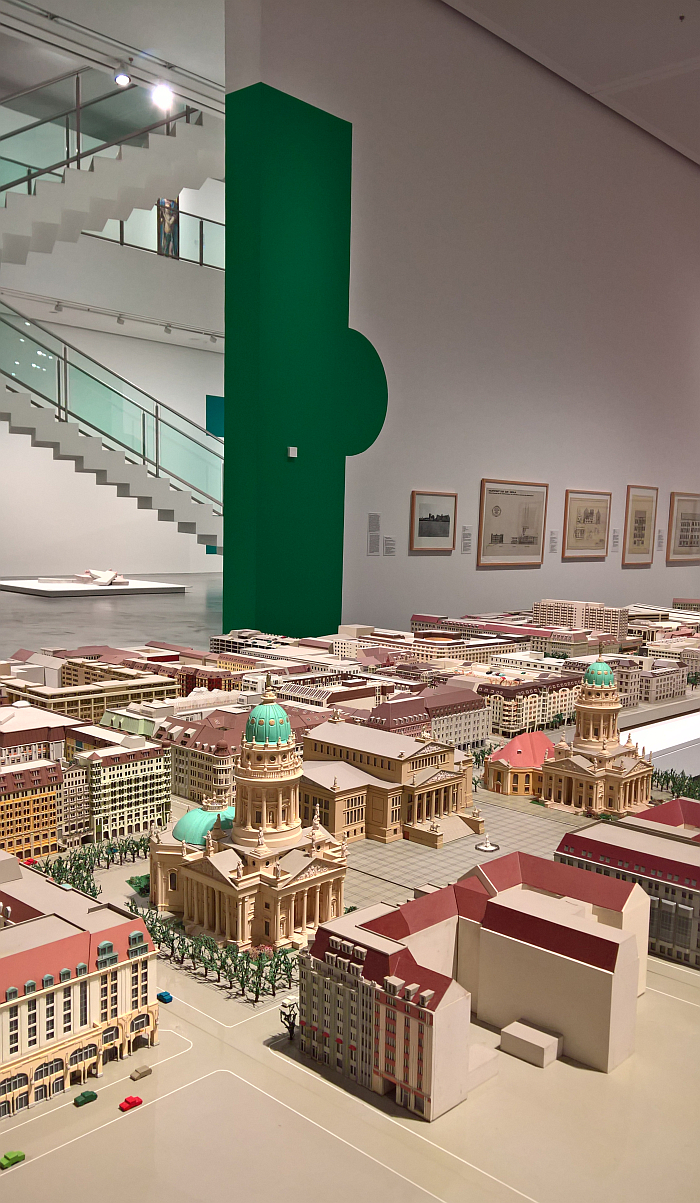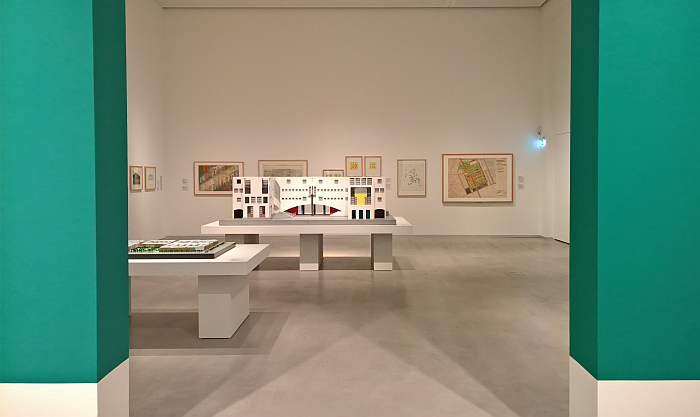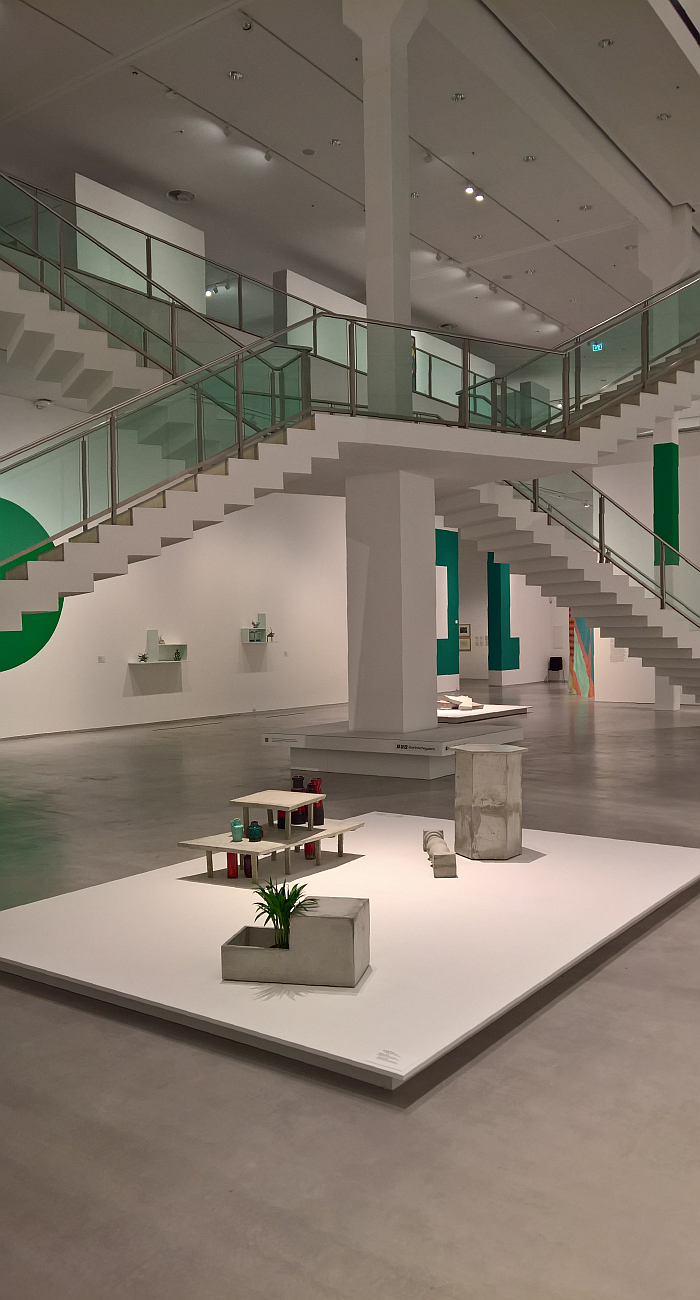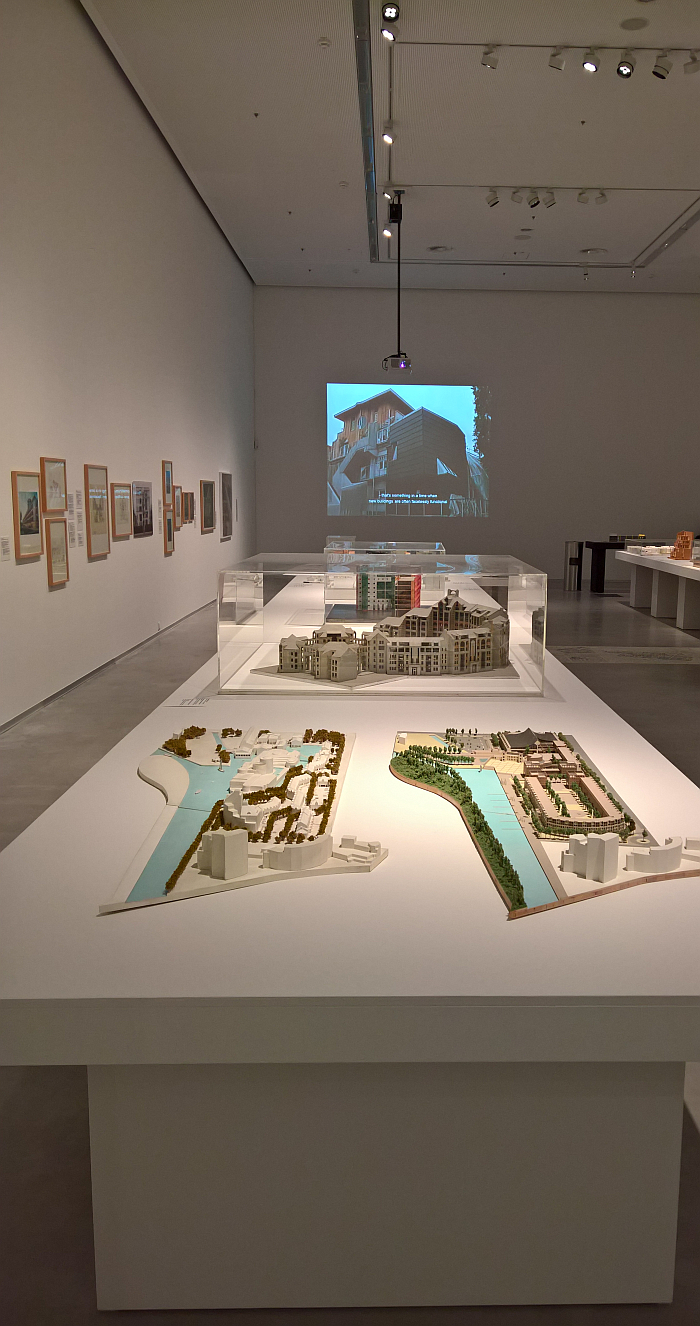Anything Goes? Berlin Architecture in the 1980s at the Berlinische Galerie, Berlin
As the worldline of architecture’s spacetime continuum moves through the 1970s and ever further into the 1980s it becomes increasingly blurry, indistinct, harder to confidently follow: established conventions and systems, acknowledged fundamental and/or necessary rules of architecture become increasingly difficult to locate.
Indeed were there rules in 1980s architecture?
With the exhibition Anything Goes? Berlin Architecture in the 1980s the Berlinische Galerie explore the architectural developments in the, then, two Berlins, and in doing so not only allow one to approach better understandings of the architectural development of the, now, one Berlin, but also to question the putative lawless of 1980s architecture…….
1980s architecture. ¯\_(ツ)_/¯
Not that the popular head scratching and shaking the architecture of the 1980s incites is the 1980s fault, it isn’t and wasn’t, indeed in many regards the 1980s could do nothing else: the second World War interrupting architecture’s natural evolution and forcing a restart, a restart which, generalising dangerously and remaining very strictly in a European context, largely sought to reconnect with the developments of the 1920s and 1930s. And a restart very much aided and abetted by the economic surge of the immediate, post-War decades, by the glow of Europe’s golden years.
However, the further away European society moved from the War the more the immediate post-War decades began to lose their shine, the gold of the 1950s and 1960s becoming increasingly understood as but a transient, deceptive, gilding; a transient, deceptive, gilding that as it faded exposed inconsistencies in contemporary European society, for all as the economic surge of the 1950s and 1960s swept headlong into the economic slump of the 1970s.
Dissatisfaction simmered.
A simmering dissatisfaction that also influenced and informed discussions and discourses on architecture, urban planning and housing provision; a simmering architectural dissatisfaction which, in many regards, boiled over in the 1980s as that which is popularly referred to as Postmodernism.
And a simmering 1970s architectural dissatisfaction with which Anything Goes? opens; a simmering dissatisfaction in a unified 1970s Berlin…..
¿ ??? ?
……or more accurately, Anything Goes? opens in two 1970s Berlins unified by simmering dissatisfaction with the realities of architecture, urban planning and housing provision in their small corners of the world; an opening, scene-setting, chapter which introduces ideas and positions that form the core of Anything Goes?‘ …Anything Goes’? ?...Anything Goes?‘ ? …Anything Goes?‘ narrative; a narrative, as Berlin in the 1980s, strictly divided in two separate entities: East Berlin and West Berlin being treated distinctly and individually. A curatorial decision we very much approve of as it helps make clear that the focus of the exhibition isn’t directly comparing what happened in East Berlin and West Berlin in the 1980s, but analysing, exploring, reflecting on (aspects of) what happened in the two Berlins in context of each’s individual political, economic, urban planning, housing provision et al realities, in context of each’s individual priorities. Which isn’t to say comparison isn’t important in viewing the exhibition, it very much is; is to say Anything Goes? is an architecture exhibition not an East/West exhibition.
An architecture exhibition whose narrative in context of East Berlin is constructed, pun intended, around two central pillars. On the one hand the revival of the city’s historic quarters, including the Nikolaiviertel and the Gendarmenmarkt with its Schauspielhaus by Karl Friedrich Schinkel. Historic quarters which until the late 1970s the East German authorities had shown only very little interest in maintaining far less reviving; a change of heart Anything Goes? understands in context of the 1987 celebrations to mark the 750th anniversary of Berlin’s founding and a desire on the part of the East German government to use the occasion to boast that they had the historic core of Berlin the imperialist West didn’t. And thus, so we continue the argument, that East Berlin was the real Berlin. If a real historic Berlin predominately revived in the 1970s and 1980s with and via thoroughly contemporary prefabricated elements and industrial construction; prefabricated elements and industrial construction which form, again pun intended, the second pillar of Anything Goes?‘ East Berlin narrative, namely a further development of the understandings of inter-War Functionalist Modernism and the post-War Functionalist Modernism of the golden gilded 50s and 60s; prefabricated elements and industrial construction which stood in direct contradiction to the Formalism Debate of 1950s East Germany and its explicit rejection of Functionalist Modernism and imperialist industrial construction; prefabricated elements and industrial construction that were necessary in context of the economic realities of 1980s East Germany and the very pressing housing shortages of the period. And prefabricated elements and industrial construction also employed for new 1970s and 80s high-rise, Plattenbau, estates in districts such as Prenzlauer Berg, Neu-Hohenschönhausen or Marzahn, the latter the largest new housing estate in East Germany and which, as Anything Goes? notes, with its civil, cultural and commercial infrastructure was, essentially, an autonomous city within/on the periphery of, the city. Not that 1980s Berlin needed any more cities within its bulging pre-War boundary.
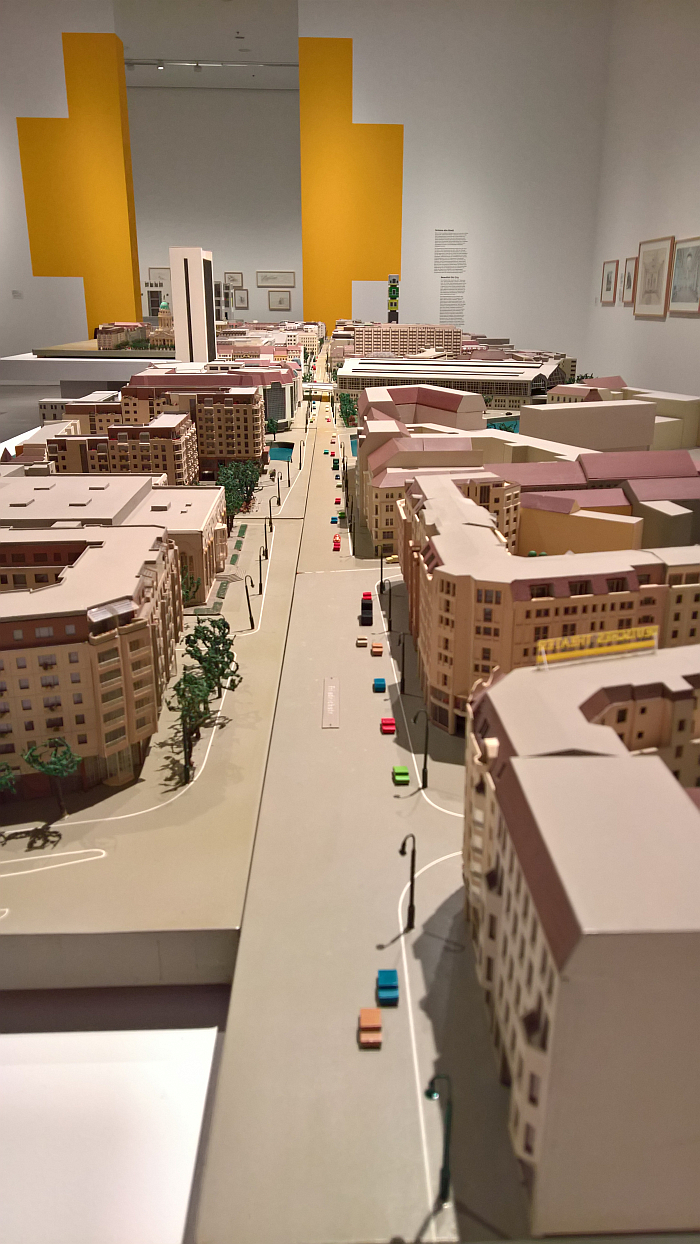
Friedrichstrasse in 1980s East Berlin, as seen at Anything Goes? Berlin Architecture in the 1980s, Berlinische Galerie, Berlin, as seen at Anything Goes? Berlin Architecture in the 1980s, Berlinische Galerie, Berlin
Whereas Anything Goes? constructs 1980s East Berlin’s narrative around two central pillars, 1980s West Berlin’s narrative sits on a single bifurcated support: the 1984/87 International Building Exhibition, IBA, with its brief to explore “Die Innenstadt als Wohnort” “The City Center as a domicile/a location one wants to live in”, and its two concepts, two alternative approaches, to achieving that, Critical Reconstruction and Cautious Urban Renewal. The former under the leadership of Josef Paul Kleihues seeking to develop new approaches to urban planning in West Berlin districts as varied as Tegel or Friedrichstadt and which, as Anything Goes? explains, saw contributions from architects such as Raimund Abraham, John Hejduk or Hans Hollein who, certainly at that time, were, largely, theoreticians and who received in 1980s West Berlin rare chances to actually build their visions rather than simply discussing them; the latter under the leadership of Hardt-Waltherr Hämer focussed very much on Kreuzberg and for all focussed on an urban renewal based on the participation of residents, based on the residents’ experiences, understandings, criticisms of Kreuzberg, and on an urban renewal which was as much about social and ecological considerations, measures and provisions, as it was about the economic or the aesthetic. And the legacy of which helps explain (aspects of) contemporary Kreuzberg.
Beyond the separate discussions on West Berlin and East Berlin Anything Goes? also features a unified discussion on Remembering and Memorializing with a focus on the many monuments and museums that arose or were planned in both Berlins in the 1980s, including the erecting of the Marx and Engels monument in Berlin….. East, and which also explores initiatives in East and West to both mark Berlin’s Jewish traditions and to remember the Shoah, initiatives perhaps best exemplified by the construction in West Berlin of the Jewish Museum by Daniel Libeskind.
Beyond the developments in 1980s East and West Berlin Anything Goes? also also features two commissioned projects: Revisited. Visiting Apartment Buildings of the 1980s by Guerilla Architects, visits which saw the collective document how selected projects featured in Anything Goes? have developed, aged, in the intervening decades, the current realities of the projects, good and less so; and Times are Hard but Postmodern, an artistic exploration and examination of the architecture of the 1980s Berlins by Isa Melsheimer.
And two projects which in their own ways help expand Anything Goes?‘ perspective on its themes and in doing so pleasingly expand the framework for your reflections and considerations on those themes.
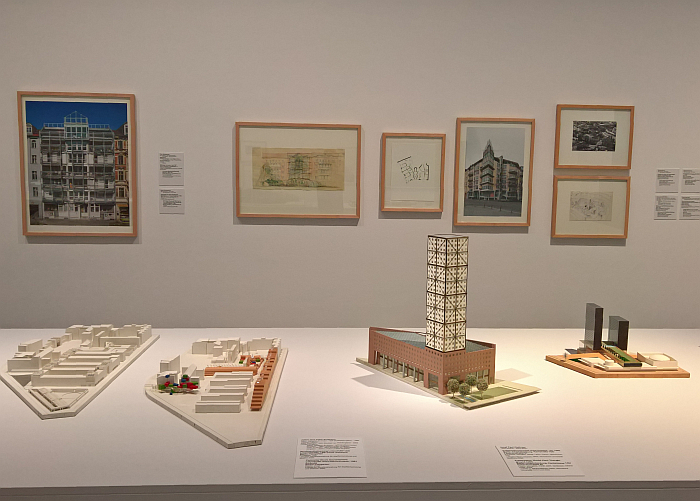
Projects developed in context of the Critical Reconstruction component of the 1984/87 International Building Exhibition in West Berlin, as seen at Anything Goes? Berlin Architecture in the 1980s, Berlinische Galerie, Berlin
Reflections and considerations aided and abetted by an intelligent exhibition concept which focuses on particular aspects of architecture in the 1980s Berlins rather than trying to cover the whole gamut: 1980s architecture in East Berlin and West Berlin was obviously a lot more than that presented in Anything Goes?; however, by restricting the gaze down to a few aspects, and for all aspects in East Berlin and West Berlin which although on the surface appear very different, with only the slightest analysis, exploration and reflection reveal themselves as astoundingly similar, as very much same same but different, Anything Goes? allows for an accessible introduction to and overview of a period in the (hi)story of architecture that isn’t always accessible, that is often ¯\_(ツ)_/¯
And that not least through the manner in which Anything Goes? neatly helps one approach an understanding that that which is popularly referred to as Postmodernism isn’t as simple to define as it often is; helps one approach an understanding that the “Post” is less a signifier of a break as a signifier of a continuation, of an evolution, of “Modernism” after it had become established, had become conventionalised, had become quotidian.1 Helps elucidate that while “Postmodernism” can be irreconcilable formal juxtaposes in pastel shades, it can also be Marzahn; while it can be classical forms and historical references in formally reduced compositions, it can also be the historical re-enactments of the Nikolaiviertel and the Gendarmenmarkt; while it can be formal, it can also be about its functional relationship to the user; while it can be brash and brazen, it can also be the Cautious Urban Renewal practised in 1980s Kreuzberg. Is something that developed out of and from Modernism as a response to reflections on Modernism’s contemporary relevance, as a response to criticisms of Modernism, not something fundamentally opposed to Modernism. And certainly isn’t a style.
In addition, through restricting the gaze down to a few carefully selected, same same but different, aspects Anything Goes? effortlessly, and very satisfyingly, allows for an accessible introduction to the whys and hows Berlin looks the way it does, helps explain the development of the city in context of the times its lived through, and thereby also helps one approach an understanding that despite what we may all be led to believe, the development of any city is never organic in the sense of natural, unstructured, rather every city is planned, just never according to one eternal, unchanging plan, much more a city is an aggregation of innumerable planning concepts and political positions developed, applied and endured over the centuries; something particularly the case in a city with the (hi)story of Berlin. And in which context, the divided presentation, the treating of East Berlin and West Berlin as separate expressions of the 1980s, and for all through treating them as equally valid/invalid expressions of the 1980s, also allows for the development of a sense of unity in the contemporary Berlin, helps one understand contemporary Berlin as a single whole rather than two that came together.
Which after 30+ years of a wall-less Berlin is no bad thing.
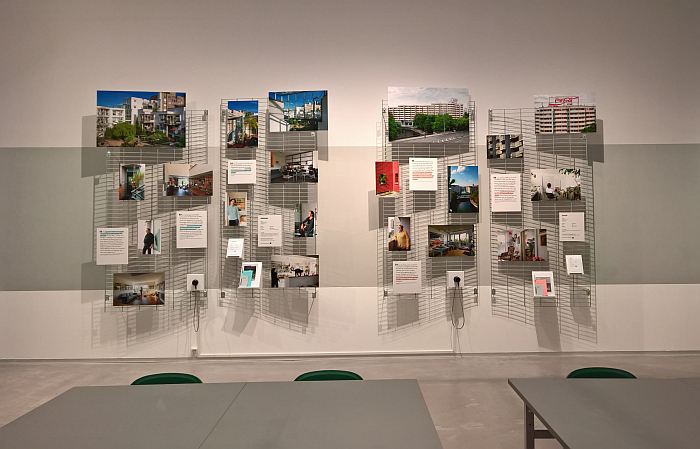
Revisited. Visiting Apartment Buildings of the 1980s by Guerilla Architects, as seen at Anything Goes? Berlin Architecture in the 1980s, Berlinische Galerie, Berlin
Presenting a mix of projects both realised and unrealised by a varied roster of international architects both well known and less well so, Anything Goes?‘ narrative predominately unfolds via photographs, sketches, plans, models etc, including a, near, 1:1 model of Friedrichstrasse as it flows through, the then, East Berlin from the Friedrichstadt-Palast down towards Checkpoint Charlie; photographs, sketches, plans, models etc backed up in the exhibition by bilingual German/English texts which concisely and comprehensibly guide you through the themes and projects. And photographs, sketches, plans, models etc backed up outwith the exhibition by three bilingual German/English Audiowalk-App tours: one in the vicinity of the Berlinische Galerie to projects realised in context of the Critical Reconstruction component of IBA 1984/87; one through Kreuzberg to Cautious Urban Renewal projects of IBA 1984/87; and one along the full length of Friedrichstrasse from Mehringplatz to the Friedrichstadt-Palast, or vice versa, and thus not only taking you past many of the projects featured in Anything Goes? but also through East Berlin, West Berlin and Berlin, and which if you do get the chance to undertake we’d very much recommend you do, it is a genuinely most satisfying way to explore the recent (hi)story of Berlin.
And a genuinely most satisfying way to explore the recent architecture of Berlin, as opposed to the ancient architecture that tends to dominate the viewing of any city.
And thus an important exploration.
For, and at the risk of contradicting Hermann Minkowski, which we obviously can’t, but which we might, one reason for the popular head scratching and shaking the architecture of the 1980s incites may be that we are standing temporally too close to it.
Walking round Anything Goes? and also strolling up and down and up and down and up and down Friedrichstrasse, we kept coming back to the thought that the reason architecture’s worldline becomes increasingly blurry, indistinct, harder to confidently follow in the course of the 1970s and 1980s may simply be because we have no discernable temporal distance from it in which to focus. Thus, so continued our thought process, we view older epochs, concentrate on, for example, the 1880s or the 1920s, those epochs from which we have sufficient temporal distance, those epochs which through a popular restriction down to a few universally accepted and acknowledged characteristics, conventions and rules are clearly readable. Those on which we can focus rather than ¯\_(ツ)_/¯
However, better understanding the architecture of the 1980s is an important element in comprehending why we are where we are; arguably more important than understanding the 1880s or the 1920s, not least because the 1980s is comprised of continuations and criticisms of previous epochs highly relevant for the 2020s. Yet although we should better understand the architecture of the 1980s we ¯\_(ツ)_/¯
That (necessary?) temporal distance to the 1980s will come; until it does, we need reading glasses.
Anything Goes? is just such a pair of spectacles.
Not only helping one approach an understanding that there is no point in looking for a Postmodern “style” because such doesn’t exist, it’s an attitude and a position; nor only helping move the view away from “good” and “bad” in architecture, or away from beautiful/ugly, and more towards meaningful/less so, durable/less so, democratic/less so, sustainable/less so, justifiable/less so etc; but also, primarily, because through the nature of the projects presented and the discussions begun, and they are only begun, it’s up to you to continue them on your own, Anything Goes? helps one approach an understanding that the 1980s was, and simplifying dangerously, (largely) about experimentation in architecture, that, if one so will, Postmodernism is but a loose synonym for experimental architecture, for all about experimentation on and with the tenets of Modernism, Functionalism, Constructivism, Neue Sachlichkeit, et al, and, and as with all architectural experimentation, be that of the 1880s, the 1920s, or the 1980s some worked, a great deal failed, but that is why you experiment, to learn from your successes and failures and thereby enabling you to move forward better informed and with more confidence in the direction your taking. That learning, that assessing the success or failure of your experiment takes time, requires distance. Or reading glasses.
And through being reading glasses for viewing 1980s architecture, through allowing objective, critical reflections on that which was undertaken in the 1980s Berlins, Anything Goes? helps one understand that, yes, 1980s architecture was very much about deliberately ignoring, violating, contradicting existing laws and rules, was very much a lawless dominion; but not for the sake of such, rather as a considered, grounded, rational even, search for new laws and rules, a search for new approaches to urban planning, new approaches to housing provision, new understandings of architecture and its relationships with the individual and with society, understandings appropriate for the coming age. Some worked, a great deal failed, but the experimentation was important, the law breaking was important, in helping us move on from where we were to where we are, and remains important as we move ever further forward; architectural experimentation, architectural rule bending and breaking, being as vital, urgent, necessary in the 2020s as it was in the 1880s, the 1920s, or the 1980s, for, as the Austrian philosopher Paul Feyerabend teaches us in context of scientific research, and which the Berlinische Galerie help elucidate is equally valid, necessary and fundamental, in terms of architecture, “the only principle that does not inhibit progress is: Anything Goes.”2
Anything Goes? Berlin Architecture in the 1980s is scheduled to run at the Berlinische Galerie, Alte Jakobstraße 124 – 128, 10969 Berlin until Monday August 16th.
Further information can be found at https://berlinischegalerie.de/anything-goes
And as ever in these times, if you are planning visiting any exhibition please familiarise yourself in advance with the current ticketing, entry, safety, hygiene, cloakroom, etc rules and systems. And during your visit please stay safe, stay responsible, and above all, stay curious……
1. Yes, by necessity defining Postmodernism requires first defining Modernism, but, here is simply neither the time nor place for that, and so, yes, there is a bit, a lot, of generalising……
2. Paul Feyerabend, Against method: Outline of an anarchistic theory of knowledge, Verso, London, 1978
Tagged with: Anything Goes?, Berlin, Berlin Architecture in the 1980s, Berlinische Galerie
